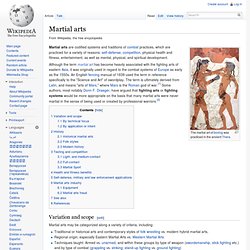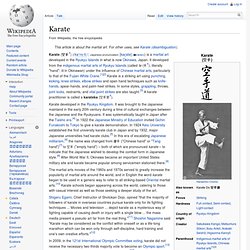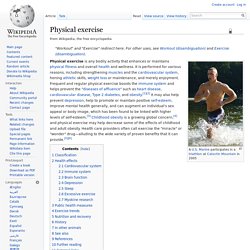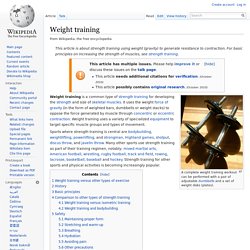

Yoga. Yoga (/ˈjoʊɡə/; Sanskrit: योग, Listen) is an Indian physical, mental, and spiritual practice or discipline.

There is a broad variety of schools, practices and goals in Hinduism, Buddhism (including Vajrayana and Tibetan Buddhism[2][3][4]) and Jainism.[5][6][7][6] The best-known are Hatha yoga and Raja yoga. The origins of Yoga have been speculated to date back to pre-Vedic Indian traditions, but most likely developed around the sixth and fifth centuries BCE, in ancient India's ascetic circles, which are also credited with the early sramana movements.
[note 1] The chronology of earliest texts describing yoga-practices is unclear, varyingly credited to Hindu Upanishads[9] and Buddhist Pāli Canon,[10] probably of third century BCE or later. The Yoga Sutras of Patanjali from first half of 1st millennium CE is one of a key surviving major texts on Yoga.[11][12] Hatha yoga texts emerged around 11th century CE, and in its origins was related to Tantrism.[13][14] Terminology. Martial arts. The martial art of boxing was practiced in the ancient Thera.

Martial arts are codified systems and traditions of combat practices, which are practiced for a variety of reasons: self-defense, competition, physical health and fitness, entertainment, as well as mental, physical, and spiritual development. Variation and scope[edit] Martial arts may be categorized along a variety of criteria, including: By technical focus[edit] Unarmed Grappling Weapon-based Those traditional martial arts which train armed combat often encompass a wide spectrum of melee weapons, including bladed weapons and polearms. Sometimes, training with one specific weapon will be considered a style of martial arts in its own right, which is especially the case in Japanese martial arts with disciplines such as kenjutsu and kendo (sword), bojutsu (staff), and kyudo (archery). By application or intent[edit] Combat-oriented Health-oriented Spirituality-oriented Martial arts can also be linked with religion and spirituality. Karate. Karate (空手?)

(/kəˈrɑːtiː/; Japanese pronunciation: [kaɽate] ( Karate developed in the Ryukyu Kingdom. It was brought to the Japanese mainland in the early 20th century during a time of cultural exchanges between the Japanese and the Ryukyuans. It was systematically taught in Japan after the Taisho era.[4] In 1922 the Japanese Ministry of Education invited Gichin Funakoshi to Tokyo to give a karate demonstration. In 1924 Keio University established the first university karate club in Japan and by 1932, major Japanese universities had karate clubs.[5] In this era of escalating Japanese militarism,[6] the name was changed from 唐手 ("Chinese hand" or "Tang hand")[7] to 空手 ("empty hand") – both of which are pronounced karate – to indicate that the Japanese wished to develop the combat form in Japanese style.[8] After World War II, Okinawa became an important United States military site and karate became popular among servicemen stationed there.[9]
Great Grandmaster Hu Yuen Chou - Choy Li Fut Kung Fu Fighting Applications. White Dragon Martial Arts - Kung Fu, Tai Chi, Kickboxing and MMA in San Diego County. Physical exercise. Classification Physical exercises are generally grouped into three types, depending on the overall effect they have on the human body:[7] Physical exercise can also include training that focuses on accuracy, agility, power, and speed.[11] Health effects Physical exercise is important for maintaining physical fitness and can contribute positively to maintaining a healthy weight, building and maintaining healthy bone density, muscle strength, and joint mobility, promoting physiological well-being, reducing surgical risks, and strengthening the immune system.

Developing research has demonstrated that many of the benefits of exercise are mediated through the role of skeletal muscle as an endocrine organ. 7 Types Of Stretching Exercises. If you work out, you've likely made stretching part of your warming up and cooling down routines.

It improves range of motion, flexibility, circulation and the overall success of your workout. Different kinds of training call for different types of stretching. Knowing them will help determine the appropriate type for your particular fitness program. Static stretching, the kind a fitness instructor leads at the end of a class, involves stretching a body part to its farthest position and then holding it for 30 seconds or more.
It does not involve bouncing or rapid movements, just a mild, painless pulling sensation. Passive stretching is similar to static stretching, except that an apparatus or partner provides the force to stretch the muscle. Dynamic stretching involves controlled swinging of the arms and legs that gently takes them to the limits of their range of motion. 30 Days of Juicing. Weight training. This article is about strength training using weight (gravity) to generate resistance to contraction.

For basic principles on increasing the strength of muscles, see strength training. A complete weight training workout can be performed with a pair of adjustable dumbbells and a set of weight disks (plates). Weight training is a common type of strength training for developing the strength and size of skeletal muscles. It uses the weight force of gravity (in the form of weighted bars, dumbbells or weight stacks) to oppose the force generated by muscle through concentric or eccentric contraction.
Weight Training. Fitness.